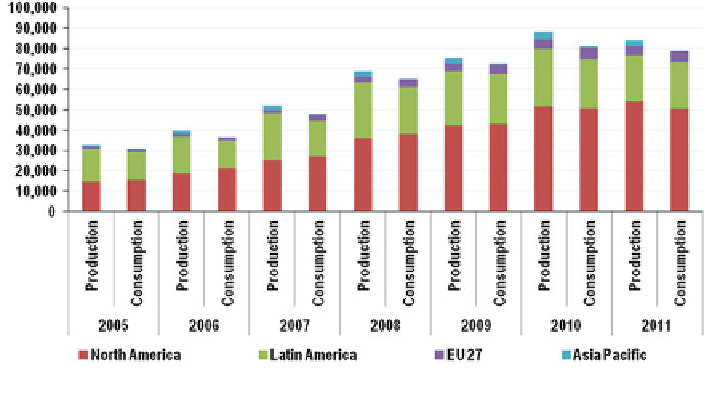Environmental Engineering Reference
In-Depth Information
Fig. 3 Regional ethanol production and consumption, 2005
-
2011 (million liters)
grown for the period under review, 2005
2011. (
http://www.globalbiofuelscenter.
com/HomeSpecialReportDetails.aspx?CID=1778&Type=2
dated 21/06/2014).
A biofuel is a type of fuel which is produced from biomass and hence is a
sustainable resource. Ethanol can be termed as bioethanol when it is produced from
any waste plant material that is composed of cellulosic material rather than starch.
Ethanol that is produced from starch- and sugar-based feedstocks such as corn and
sugar cane is not
-
termed as bioethanol. Starch-based feedstocks require little
modi
ciently by hydrolysis of starch to be
fermented by microorganisms to ethanol. Bioethanol is produced from waste bio-
mass feedstocks of cellulosic nature in the agricultural and forestry process such as
corn stover, rice straw, rice husks, sugarcane bagasse, and wheat straw. This is a
much harder process as the cellulose is inaccessible due to the composition of the
biomass.
Lignocellulosic feedstocks are composed mainly of cellulose (30
cation, and sugars are generated ef
50 %), lignin
-
(15
-
25 %), hemicellulose (20
-
40 %), extractives, and ash consisting of inorganic
minerals (5
-
35 %) (Kumar and Murthy
2011
). Cellulose is a glucose polymer
linked by
-1,4-glycosidic bonds which is linear and packs well due to having few
branches in the chain. Hence, it is a polysaccharide that can be hydrolyzed into
glucose monomer units and the process is called as sacchari
β
cation. Hemicellulose
is a short highly branched polymer of C5 and C6 sugars composed mainly of
xylose, arabinose (C5), galactose, glucose, and mannose (C6) (Brethauer and
Wyman
2010
). Due to its highly branched nature, it can be readily hydrolyzed into
sugar monomers with a major product being xylose. Lignin is a phenolic polymer
that cannot be utilized in the fermentation process and it binds cellulose and
hemicellulose into a coherent structure which makes up the plant cell wall.

Search WWH ::

Custom Search